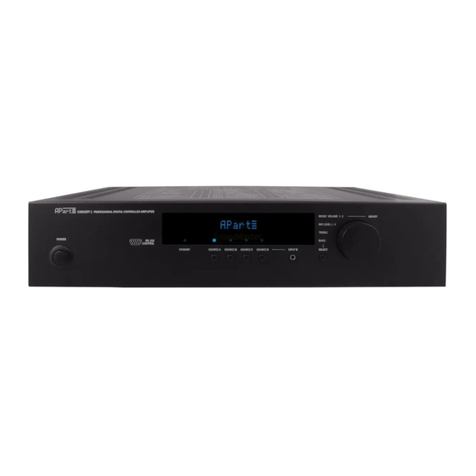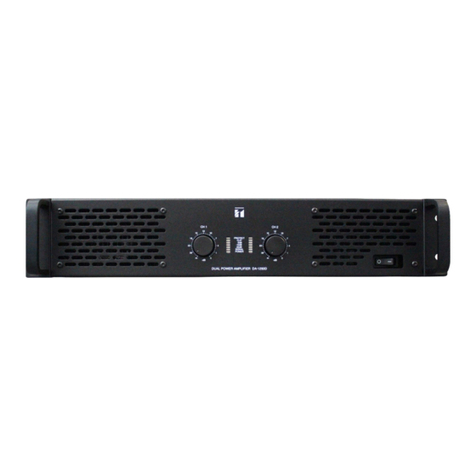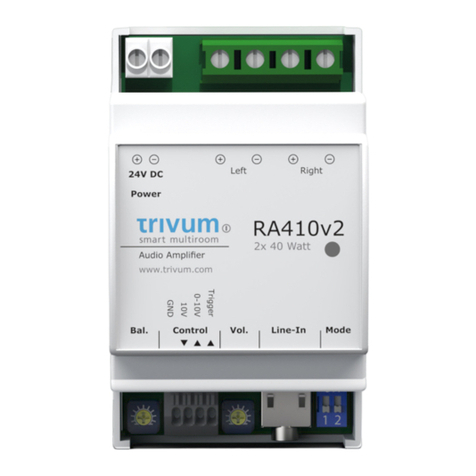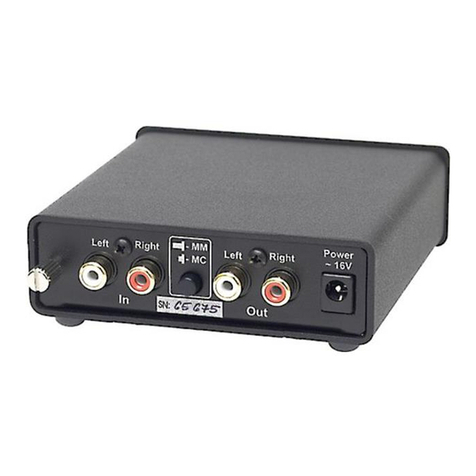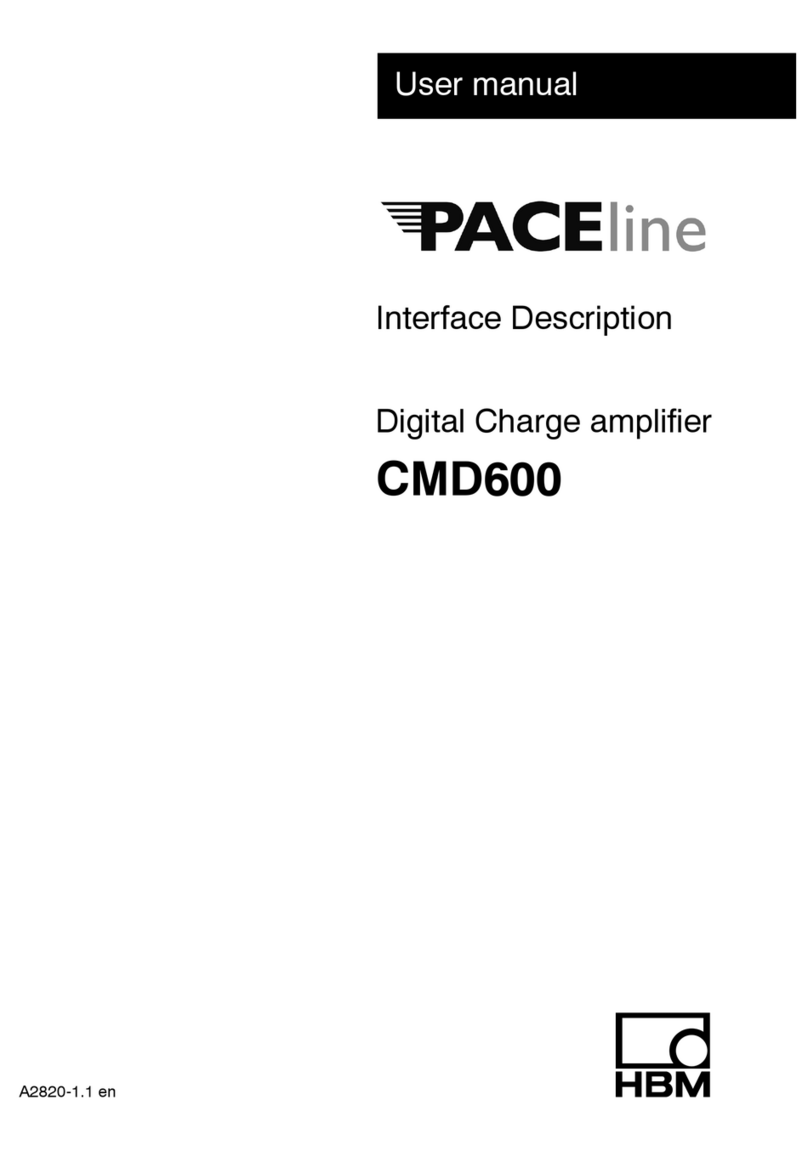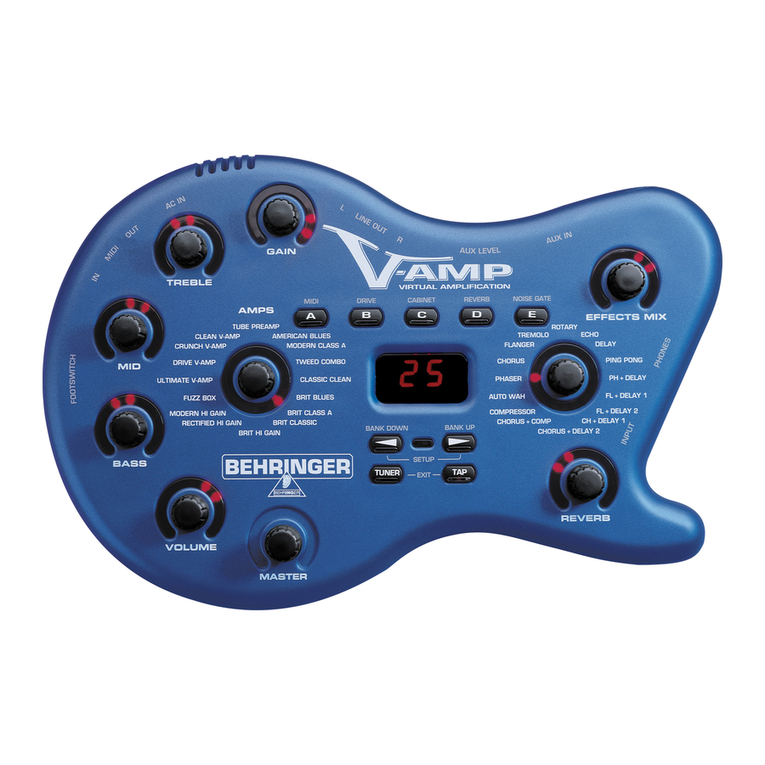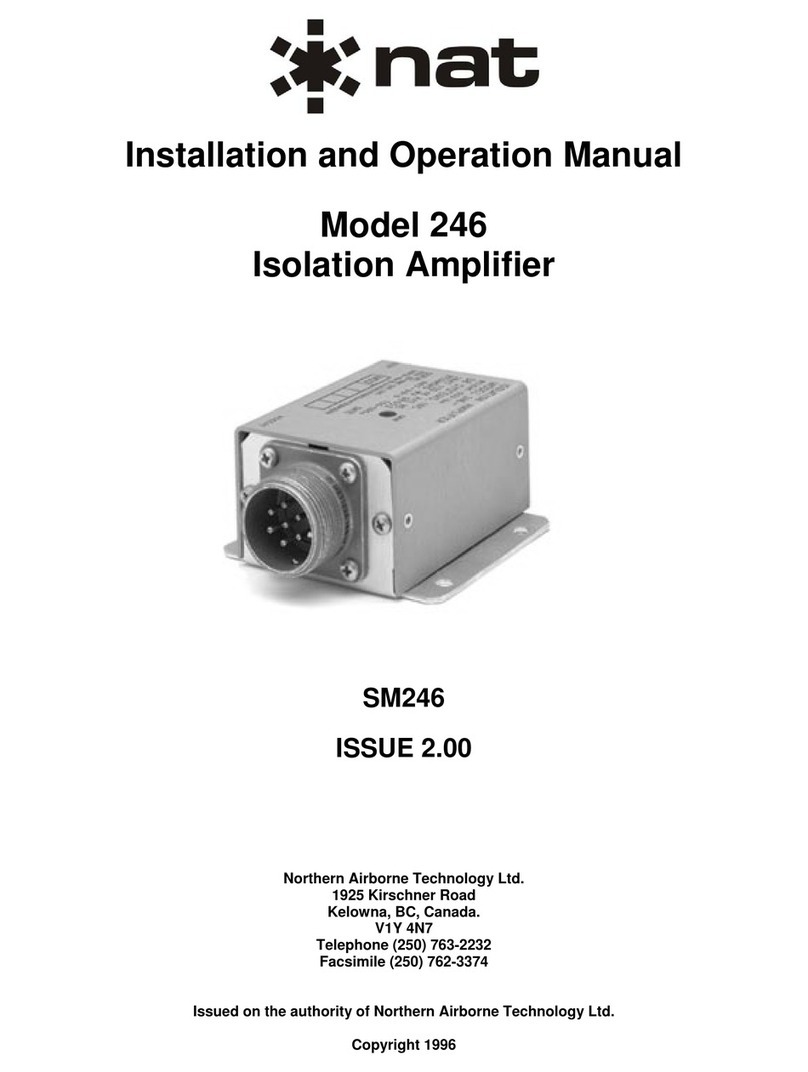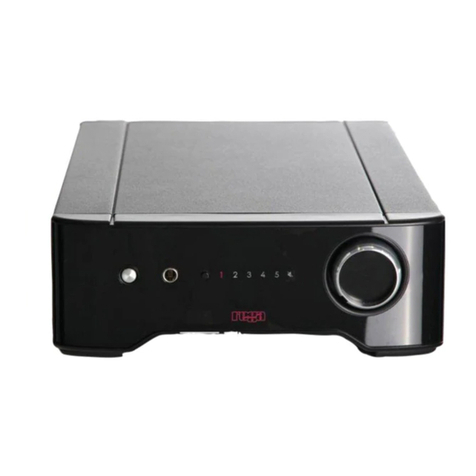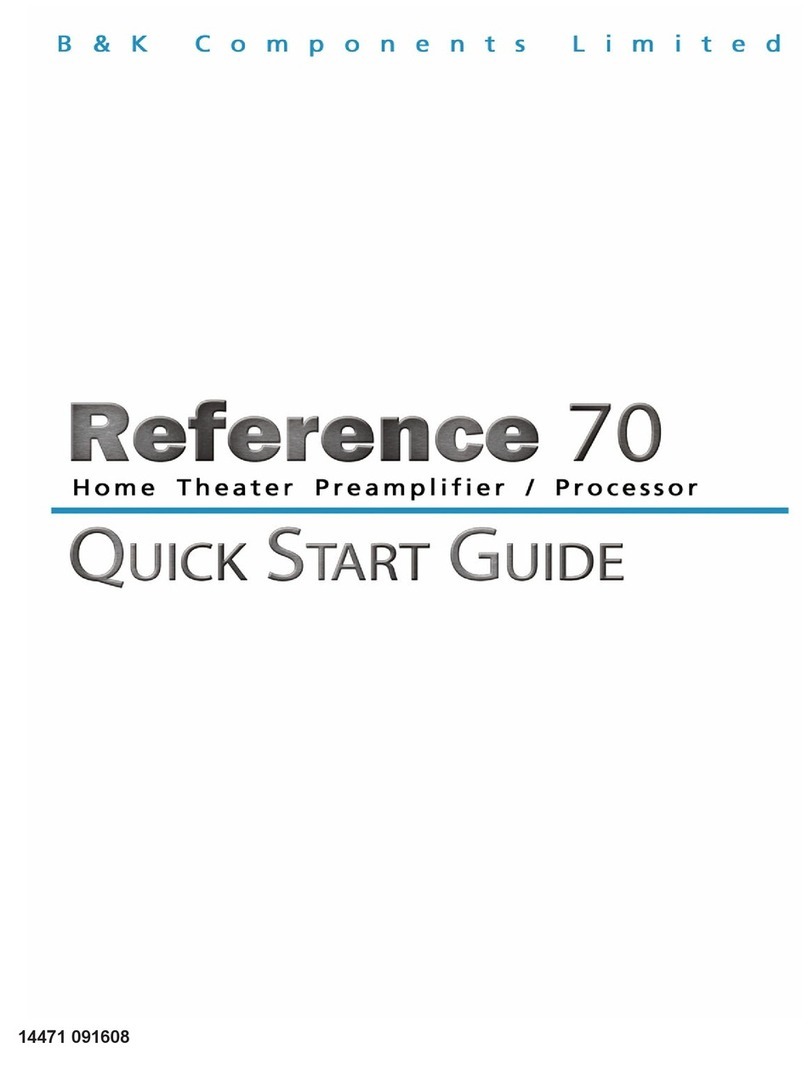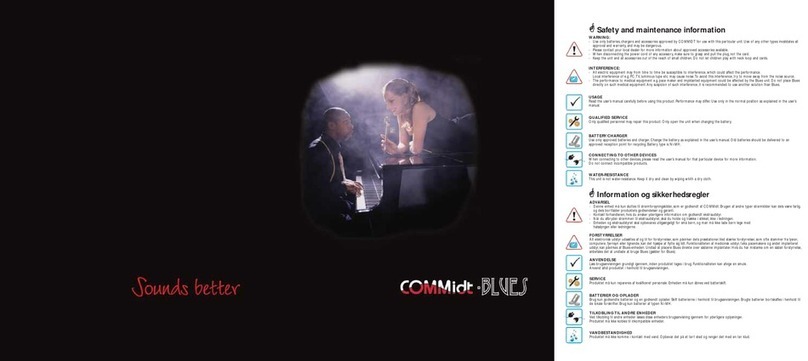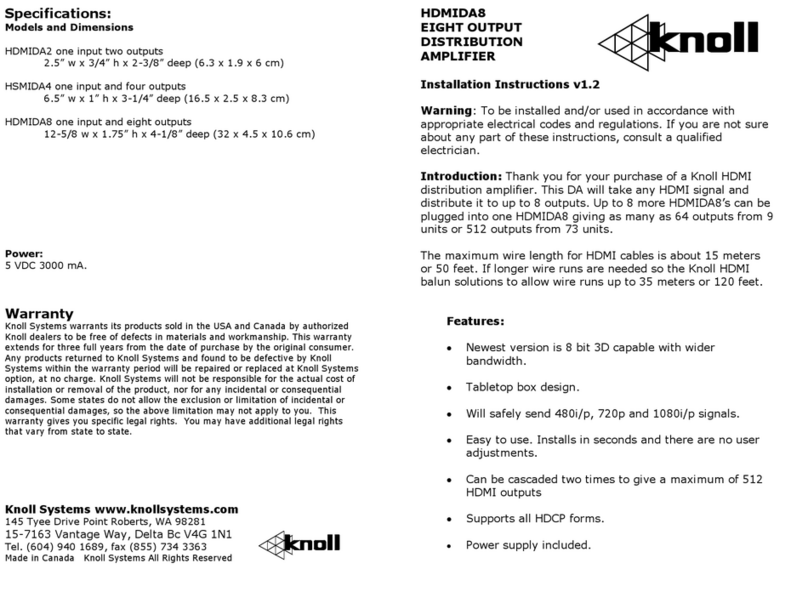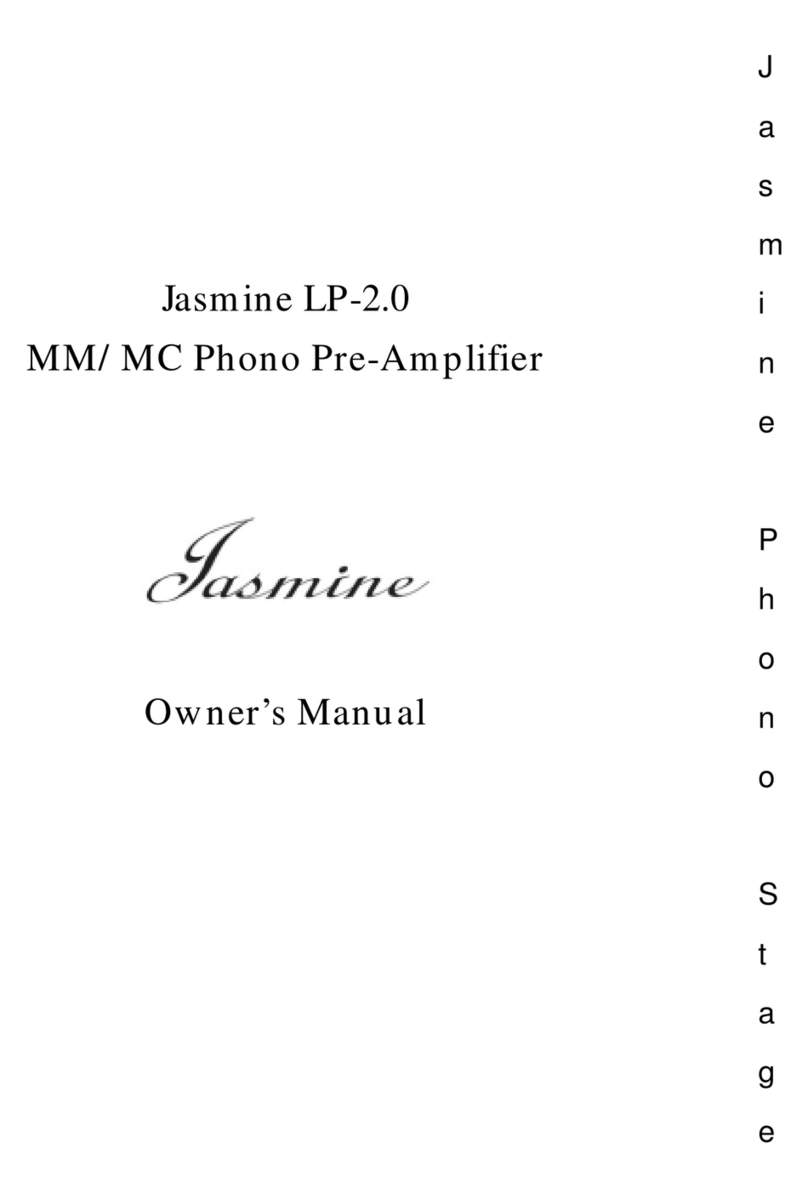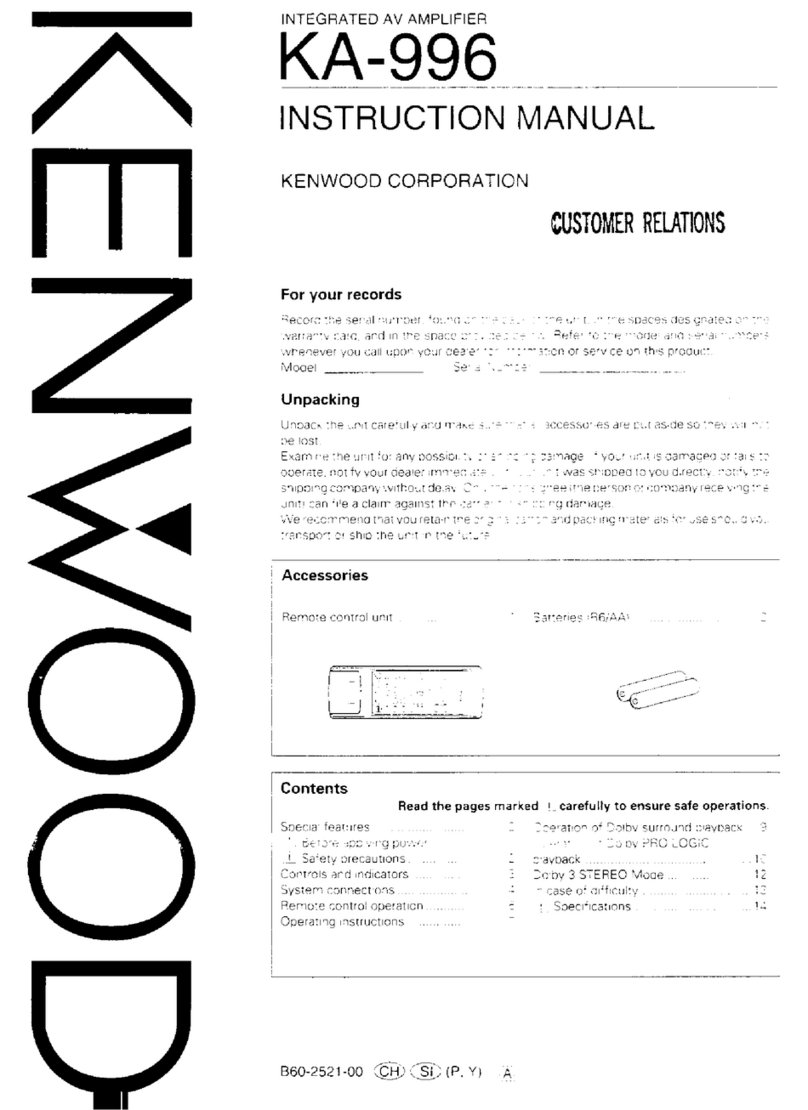Tone King Imperial MK II User manual

Tone King
“Imperial*MK*II”*
User’s&Manual&
Tone King Amplifiers www.toneking.com
Note%from%the%Builder%%

1
Thank you for choosing the Imperial MK II guitar amplifier. The Imperial was the very
first production model built by Tone King. It was introduced in 1993, and has been a
favorite of guitarists for over 20 years now. The MK II update incorporates all that I’ve
learned as an amp designer over these past 20 years, without changing the essential
character of the amp. If anything, the MK II digs deeper for an even more authentically
vintage sound and feel.
I designed the Imperial back in 1990-1993. At the
time, I was inspired by listening to vintage amps such
as the Fender Deluxe Reverb and the Fender Tweed
Deluxe. It was clear that the authentic vintage amps
had a certain mojo that was missing in modern amps.
They had a certain feel that made you want to play
them – a compliant, broken-in feel. They also had a
certain transparency to their tone, a harmonic
complexity, and an expressive quality that I couldn’t
find in new amps at the time. My goal was to build a
new amp that could capture that that vintage magic.
Being an Electrical Engineer, I was able to absorb a lot
of the electronic necessities of such as design fairly readily, but I hit a stopping point
when it came to the cabinet design. After prototyping electronic designs using a fine
sounding vintage speaker cabinet, I became quite aware of the important role the
cabinet can play once I built my first speaker cabinet, to disappointing results. After
years of building test cabinets, experimenting with wood types, construction methods,
and many other factors, I began to develop a sense for how to control the voicing of a
cabinet to achieve the sound and feel I was after. The Imperial was the first of my
designs to benefit from these efforts in cabinet design, and I like to think that this is
why it is such a special amp that has been so successful for all these years.
Still, being primarily an experimenter, I never
stopped trying to learn new ways to improve my
designs. This new MK II design incorporates
development work I’ve done over the past 20
years and represents the best of what I can do at
this time.
To be specific, the MK II is built using a layout
scheme I’m calling “handwired board”, which I
believe to be an ideal construction method to extract the best tone from any circuit
design. It has great advantages in terms of component placement, wiring length, and
wire routing, and has a real, tangible effect on the sound and feel of an amp.
In addition, the MK II includes the new Ironman/II attenuator, which I feel is a great
advance in that it provides fletcher-munson volume compensation to correct for the
way the ear perceives sound at low volume, as well a circuitry that compensates for the
way the speaker operates at low volume, to preserve the experience of playing a
cranked amp at low volume better than had been done before.
I thank you for your purchase of this special version of the Imperial, and I hope you
enjoy playing it as much as I do.
Tone King Amplifiers,

2
Safety%Instructions%%
Please keep this instruction manual for future reference and for the duration of owning
this Tone King Amplifier. Please carefully read and understand the instructions inside
this user’s manual before attempting to operate your new amp. This instruction manual
includes essential safety information regarding the use and maintenance of the
amplifier. Take special care to heed all warning symbols and signs inside this manual
and those printed on the amplifier itself.
WARNING!
TO PREVENT FIRE OR SHOCK HAZARD, DO NOT EXPOSE THE AMPLIFIER TO WATER OR
MOISTURE. DO NOT OPERATE NEAR ANY WATER SOURCE
WHAT’S THE MEANING OF THIS?
The lightning flash with an arrow triangular symbol is intended to alert the user to the
presence of non-insulated “dangerous voltage” within the products enclosure, and may
be of sufficient magnitude to constitute a risk of electric shock
WHAT’S THE MEANING OF THIS?
The exclamation point triangular symbol is intended to alert the user to the presence of
important operating and maintenance (servicing) instructions in the user manual
accompanying this amplifier!
1. Read Instructions – All the safety and operating instructions should be read
beforethis product is operated.
2. Retain Instructions – The safety and operating instructions should be retained
forfuture reference.
3. Heed Warnings – All warnings on the amplifier and in the operating
instructionsshould be adhered to.
4. Follow Instructions – All operating and use instructions should be followed.
5. Water and Moisture – The amplifier should not be used near water – for example,
abathtub, washbowl, kitchen sink, laundry tub, wet basement, or near a swimming
pool, and the like.
6. Carts and Stands – The amplifier should be used only with a cart or stand that
isrecommended by the manufacturer.
An amplifier and cart combination should be moved with care. Quick stops, excessive
force, and uneven surfaces may cause the amplifier and cart combination to overturn.
7. Wall or Ceiling Mounting
– The product should never be mounted to a wall or ceiling.

3
8. Heat – Amplifier should be situated away from heat sources such as radiators,
heatregisters, stoves, or other amplifier (including amplifiers) that produce heat.
9. Power Sources – This product should be operated only from the type of power
sourceindicated on the rating label.
If you are not sure of the type of power supply to your home, consult your product
dealer or local power company.
10. Grounding or Polarization
– This product may be equipped with a polarized alternation-current line plug (a plug
having one blade wider than the other). This plug will fit into the power outlet only one
way. This is a safety feature. If you are unable to insert the plug fully into the outlet, try
reversing the plug. If the plug should still fail to fit, contact your electrician to replace
your obsolete outlet. Do not defeat the safety purpose of the polarized plug.
11. Power-Cord Protection
– Power-supply cords should be routed so that they are not likely to be walked on or
pinched by items placed upon or against them, paying particular attention to the cord
in correspondence of plugs, convenience receptacles, and the point where they exit
from the amplifier.
12. Cleaning – The amplifier should be cleaned only as recommended by the
manufacturer. Clean by wiping with a cloth slightly damp with water. Avoid getting
water inside the amplifier.
14. Non-use Periods – The power cord of the amplifier should be unplugged from
theoutlet when left unused for a long period of time.
15. Object and Liquid Entry
– Care should be taken so that objects do not fall and liquids are not spilled into the
enclosure through openings.
16. Damage Requiring Service
– The amplifier should be serviced by qualified service personnel when:
A. The power-supply cord or the plug has been damaged; or
B. Objects have fallen, or liquid has been spilled into the amplifier; or
C. The amplifier has been exposed to rain; or
D. The amplifier does not appear to operate normally or exhibits a marked change
inperformance; or
E. The amplifier has been dropped, or the enclosure damaged.
F. The amplifier needs tube replacement or biasing
17. Servicing – The user should not attempt any service to the amplifier beyond
thatdescribed in the operating instructions.
All other servicing should be referred to qualified service personnel.
18. Ventilation – Slots and openings in the cabinet are provided for ventilation and
toensure reliable operation of the product and to protect it from overheating, and
these openings must not be blocked or covered. The openings should never be blocked
by placing the product on a bed, sofa, rug, or other similar surface. This product should
not be placed in a built- in installation such as a bookcase or rack.
19. Attachments – do not use attachments not recommended by the
productmanufacturer as they may cause hazards.

4
20. Accessories – Do not place this product on an unstable cart, stand, tripod,
bracket,or table. The product may fall, causing serious injury to a child or adult, and
serious damage to the product. Use only with a cart, stand, tripod, bracket, or table
recommended by the manufacturer, or sold with the product.
21. Lightning – For added protection for this product before a lightning storm, or
when itis left unattended and unused for long periods of time, unplug it from the wall
outlet.
This will prevent damage to the product due to lightning and powerline surges.
22. Replacement Parts – When replacement parts are required, be sure the
servicetechnician has used replacement parts specified by the manufacturer or have
the same characteristics as the original part. Unauthorized substitutions may result in
fire, electric shock, or other hazards.
23. Safety Check – Upon completion of any service or repairs to this product, ask
theservice technician to perform safety checks to determine that the product is in
proper operating condition.
24. FUSES – Always use the correct rating and type of fuse as indicated on the
rearpanel. Note the proper rating fuse is determined by the AC line voltage in the
country this unit is being operated.
25. AC SELECT SWITCH: This switch must be set to match the AC line voltage in
thecountry this unit is being operated.
To change the setting, loosen (do not remove) the two screws above and below the
slide switch. Temporarily move the protective cover strip and slide the actuator to
match the voltage in your country. Place the protective cover strip back over the switch
and tighten the two screws.

5
Contents%%
1. Front Panel Controls 4
Two Preamp Channels – Lead and Rhythm 4
Rhythm Channel 4
Lead Channel 5
Reverb 6
Tremolo (Rate & Depth) 6
2. Back Panel Controls 7
AC Power 7
Fuse 7
Power Switch, Standby Switch 7
Footswitch 7
Speaker Jack 8
Attenuation Controls 8
3. Ironman/II Attenuator 9
Purpose of the Attenuator 9
Attenuator Controls 10
How to Use the Attenuator 10
HF Comp Switch 11
Rhythm Channel Bypass Switch 11
4. Getting a Great Sound at Home 12
The Effect of Your Acoustical Environment 12
Floor Reflections 12
Where to Place the Amp 12
Carpeting 12
Backwards Amp Trick 13
The Attenuator Can Help 13
5. Tube Installation and Replacement 14
Choice of Tube Types and Brands 14
Alternate Tube Choices 15
Installing Tubes 15
Replacing Output Tubes 15

6
Tube Quality 16
6. Warranty 17
7. CE Declaration 18

7
1.%Front%Panel%Controls%
Two$Preamp$Channels$–$Lead$and$Rhythm$$
The Imperial has two separate preamplifier channels, each with its own unique voicing.
You can switch between the channels with either the “Lead/Rhythm” switch (on the
front panel) or with the “Channel” switch on the footswitch. When using the footswitch,
you should set the front panel switch to the “Rhythm” position. You’ll notice that the
LED on the footswitch indicates the channel selected. When the LED is lit, the Lead
channel is selected. When the LED is not lit, the Rhythm channel is selected.
Rhythm$Channel$$
The Rhythm channel includes controls for Volume, Treble, and Bass. This channel is
designed to deliver a “vintage 1960’s clean tone”. In previous versions of the Imperial,
it had been suggested that this channel be used only for clean tones, since it’s
overdriven sound could become a bit harsh. However, layout improvements made in
this new MK II design have had a big effect on the overdriven tone of the Rhythm
channel. It can now deliver a fantastic range of usable overdriven tones in addition to
its sparkling clean tone.
The Bass and Treble controls act much like they would on a genuine vintage amp of
this type. Here are two sample settings that demonstrate the sound that the Rhythm
channel was designed to deliver:
!"#$%&'()*(+&,-%#&
Volume
Treble
Bass
Reverb
3
4
6
5
This is the clean sound the Imperial was designed for. Sweet, punchy, and
balanced. Plug in a strat with the (bridge+middle) position, and you’ll get a
nice ‘Sultans of Swing’ tone. Try the middle pickup position of a tele to get a
nice rich sound with just the right amount of bite on top. Bridge pickup
settings on any single coil guitar should give you a nice balance – great clarity
and just the right amount of brightness.&
!.$%/#0&'()*(+&!($%%#"&12#.0.32#&
Volume
Treble
Bass
Reverb
8
5
6
4
Here’s a great setting that sounds like an old twin reverb run flat
out on 10. It’s perfect for plugging in your telecaster and pulling
out those Roy Buchanan licks. A strat can be great as well, using
the bridge pickup. You may want to use the attenuator with this
setting – it will be loud otherwise.
Lead$Channel$$
The Lead channel starts out with a Tweed style preamp, which drives a proprietary
tone-shaping circuit built around the Mid-Bite control, a unique Tone King feature.
This proprietary circuit transforms the basic tweed tone to more of a crunchy rock tone

8
as you turn up the mid-bite control. This is accomplished by simultaneously tightening
up the bass, rolling off the very high frequencies, increasing the gain, and developing a
pronounced upper midrange peak. The Mid-Bite control is the key to dialing in your
own particular sound on the lead channel, so you may want to experiment and observe
its effect as you rotate it from 1 to 9.
Here are a few sample settings which demonstrate the tones that the Lead channel is
designed to deliver:
1"0&4*)"#&5$*&!"#$%&
Volume
Tone
Mid-Bite
Reverb
2
3
1
1
This is a nice setting that has many uses. It’s a fatter clean sound than you
get from the Rhythm channel, with a slight boxiness and a smooth top end.
Plug in a telecaster, and it’s perfect for honky tonk or old time country music.
Plug in a hollowbody jazz box, and you’ll get pretty close to Wes Montogomery
or Grant Green tones. &
5$*&,6##0&12#.0.32#&
Volume
Tone
Mid-Bite
Reverb
9
4
1
3
This setting is a nice chunky overdriven sound inspired by the sound of a
tweed deluxe on 10. It’s great for blues playing, and really shines with single
notes and double stops.
'-7/&8&'-""&,6##0&12#.0.32#&
Volume
Tone
Mid-Bite
Reverb
6
5
8
2
This setting is more rock & roll, but still retains a lot of the ‘tweed deluxe’
character. It gives you a tighter bottom end and creamier mids than the
previous setting, so it’s great for playing rock chord rhythms and singing
single-note lines. When using this setting, I’m tempted to pull out some Billy
Gibbons licks, or possibly something like ‘Cat Scratch Fever’, but I’m sure
you’ll find many great uses for it.
Reverb$$
The Imperial includes a built in 2-spring, tube-driven reverb circuit. Reverb is applied
to both the Rhythm and Lead channels. In order to compensate for the higher gain of
the Lead channel, the reverb drive is reduced slightly on the Lead channel. This
reduction helps to match the reverb level when switching between preamp channels,
when the Lead channel is being driven hard and the Rhythm channel is set for a clean
tone.
The Reverb level is controlled by the front panel Reverb control, which adjusts the
amount of the reverb signal which is mixed into the signal path.

9
Tremolo$(Rate$&$Depth)$$
The Imperial’s tremolo circuit is a modified form of the old-fashioned “bias modulation”
tremolo circuit. This circuit achieves the tremolo effect by varying the bias of the
output tubes. This type of tremolo was used in all Tone King amps going back to 1993.
However, the Imperial MK II uses a modified form of this circuit which virtually
eliminates the “thumping” and other sonic effects that are typical for this type of effect.
This is the same circuit which was used on the 20th Anniversary Imperial.
This type of tremolo circuit gives you a nicely rounded effect, but it is quite subtle when
compared to an opto-coupler tremolo (as would be found in, for example, a Fender Twin
Reverb).
The “Depth” control varies the intensity of the modulation effect, and the “Rate” knob
controls the speed of the effect.
If the footswitch is not being used, then the tremolo circuit is active all the time, so you
will need to turn the “Depth” knob all the way down if you do not wish to use tremolo.
When the footswitch is plugged in, you can turn the tremolo on and off with the
footswitch. An LED shows the status of the effect (LED on = tremolo on)
2.%Back%Panel%Controls%
AC$Power$$
Always use a grounded AC cord, and make sure that a proper ground connection is
supplied to the amp. Never attempt to lift or defeat the ground connection to the amp.

10
Fuse$Power$Switch,$Standby$Switch$$
A standard 2A slo-blo fuse (style 3AG) should be used.
When powering up the amp, you should start with both the Power and Standby
switches in the "off" position.
First, turn on the Power switch. This will apply power only to the tube filaments and
the low-voltage circuitry.
After turning on the Power switch, allow the tubes to warm up for about 1 minute, then
turn on the Standby switch.
The power-down sequence is not as important as the power-up sequence. When
turning the amp off, you may turn Power off before Standby, or turn Standby off before
Power, or turn them both off at the same time.
Footswitch$$
Connect the footswitch to the amp with the supplied cable, or with any standard ¼”
TRS (Stereo) -to- ¼” TRS (Stereo) cable.
The footswitch allows you to control both the preamp channel selection and the tremolo
on/off. LEDs indicate the current switching status, as follows:
Channel switch: LED on = Lead channel
Tremolo switch: LED on = Tremolo on
When using the footswitch, make sure to set the front panel Channel switch to the
Rhythm position.
Speaker$Jack$$
The Imperial has a single speaker jack with an impedance of 8 Ohms. If you wish to
use an extension cabinet, it’s best to use an 8-ohm cabinet. You can connect it with a
standard ¼” mono speaker cable by pulling out the plug from the internal speaker, and
plugging the cable into the speaker jack.
If desired or necessary, you may safely mismatch the impedance by as much as
doubling or halving the selected impedance. Mismatching beyond this is not
recommended. For example, you may safely use a total speaker load as low as 4 ohms
or as high as 16 ohms.
$
Ironman/II$Compensated$Power$Attenuator$$
The Imperial MK II contains the new Ironman-II precision compensated power
attenuator. The Ironman-II’s new architecture goes a step beyond the original Ironman
design. It includes circuitry which helps compensate for the way your ear perceives
sound at very low volume, and also for the way the speaker performs at very low power.
This compensation circuitry helps preserve the full, rich sound with plenty of presence
at even bedroom volume.
The operation of the Ironman/II will be described in detail in the following section.

11
$
Purpose$of$the$Attenuator$$
The Imperial is designed so that, when driven into overdrive and distortion, most of the
distortion is generated in the output tubes (and the phase inverter). Output stage
distortion has a different sound and feel than distortion generated in the preamplifier,
and this is big part of why the Imperial sounds the way it does. The problem with this
sort of design is that the only way to generate any overdrive or distortion is to push the
output stage to the maximum output power, which means it will be very loud. This
level of volume is impractical for many circumstances, so it is necessary to find a way to
lower the volume level while still maintaining the great sound of overdriven power
tubes.
The best solution to controlling volume level while still allowing the output tubes to
generate maximum output power is to use an attenuator. An attenuator is a circuit
which allows you to divide the power generated by the amplifier between the speaker
and a specially designed load circuit. In doing so, you can adjust the amount of power
sent to the speaker, with the rest of the remaining power being absorbed in the load
circuit, as shown in the diagram below:
Attenuator$Controls $
As you can see from the illustration on the previous page, the attenuator controls
consist of one rotary knob to select the attenuation level, and two switches to control
other functions which will be described below.
3
.%Ironman/II%Attenuator

12
On the Attenuation dial, 0db is the loudest setting. In this setting, the attenuator is
fully bypassed, and the speaker is connected directly to the output of the amplifier.
The –36db setting is the quietest setting. In this setting, most of the power generated
by the output tubes is absorbed by the attenuator, and only a few dozen milliwatts of
power are sent to the speaker.
$
How$to$Use$the$Attenuator $
First, lets start with the basics of how to use the attenuator. For practical purposes,
the Attenuation knob can be thought of as providing the same function as a “master
volume” control. This means that you will use the “Volume” controls to adjust the gain
of the preamp and the amount of overdrive/distortion you wish to dial in, and you will
use the “Attenuation” dial to set the volume level that you wish to produce.
You may wish to experiment to confirm this behavior. For example, try selecting the
lead channel, and setting the amp up like this:
Volume
Tone
Mid-Bite
Reverb
Attenuation
HF Comp
6
5
8
2
-24db
Max
Now, while playing through the amp, try turning the Volume control up and down a bit.
You will see how slight changes in the Volume control will make the tone more or less
distorted but won’t have much effect on the volume level in the room. The reason for
this is that the output stage of the amplifier is already generating maximum output
power even if the amp is only just on the edge of breakup. As you turn up the Volume
control past this point, the output stage cannot produce any more power – it just
becomes more overdriven.
After trying that experiment, set the volume control back to 6, where you started, and
try adjusting the attenuation knob on the back of the amp. You will see that the
volume level in the room changes, but the amount of overdrive and distortion does not.
This is the purpose of the attenuator.
HF$Comp$Switch$$
As was previously mentioned, the Ironman/II contains special compensation circuitry to
adjust the EQ curve and the amount of compression/presence progressively as the
Attenuation knob is turned from 0 to its maximum setting of –36db. The HF Comp
switch allows you to select between two different levels of compensation, Max and

13
Normal. The Max setting will give you a bit more presence and a brighter sound. The
Normal setting will give you a little more compression, and a smoother top-end.
The purpose of this switch is to help you match the sound of the amp to the acoustic
properties of your room. The characteristics of the room have a much bigger influence
on the sound when you are attenuating down to a low volume than they do at high
volume. By having two levels of compensation, you have the ability to tailor the amount
of presence and compression to complement the characteristics of your room.
For example, if you are playing in a very bright sounding room, then you might choose
the Normal setting. Alternatively, if you are playing in a larger, more reflective room
that tends to muddy the sound of an amp, you might prefer the Max setting.
The proper setting is a matter of personal preference, so you may want to try both and
pick the one that appeals most to you.
Rhythm$Channel$Bypass$Switch$
This switch solves a particular problem: If you want to switch back and forth between
an overdriven sound on the lead channel and a squeaky clean sound on the Rhythm
channel, you may find it difficult to get enough clean volume on the Rhythm channel to
match the overdriven volume on the Lead channel.
This switch solves the problem. Here’s how it works:
Bypass: When set to ‘Bypass’, the attenuator is bypassed whenever the rhythm
channel is selected. This means that the full power developed by the output tubes will
be delivered to the speaker when the Rhythm channel is selected, regardless of the
Attenuation knob setting. However, when you switch to the Lead channel, the
attenuator will be become active again, and will reduce the volume level according to
the setting of the Attenuation knob.
In this mode, as you switch between Lead and Rhythm channels (using either the front
panel Channel switch or the footswitch), the attenuator will automatically be turned off
(bypassed) and on (enabled), depending on the channel you have selected.
Enable: In this mode, the attenuator will be on (enabled) no matter what channel is
selected.
4.%Getting%a%Great%Sound%at%Home%
The$Effect$of$Your$Acoustical$Environment$$
When playing in a large room or on a big stage, getting a great sound from your amp is
easy. Generally, in this type of setting, you would simply crank the amp up to full
power, and it will sound great.
Playing at home, or in any small room, is a different story. In a case like this, the
acoustic properties of the room can have more of an influence than the amplifier can,
and will often conspire to cause real problems with the sound you hear from your
amplifier.

14
There are many types of problems that can happen in a small room. Here are a few
suggestions for how to deal with them:
Floor$Reflections$$
If you have the amp sitting on a hardwood, tile, or concrete floor in a small room, it may
sound harsh in the upper midrange, because of reflections off the floor in front of the
amp. To help solve this problem, you might try placing a small piece of carpet (or a
doormat, for example), directly in front of the amp.
Where$to$Place$the$Amp$$
To begin, it should be noted that the Imperial is always at its best when placed directly
on the floor (with one exception, which will be noted later). If it is positioned off the
floor, on a stand or some other device, the tonal balance will not be optimal. It will
sound thinner and brighter than it should.
Next, you will find that the sound you hear is greatly influenced by where you place the
amp in the room, and by the orientation of the amp with respect to the listening
position (i.e. if the amp is pointing at you or away from you).
I strongly suggest experimenting by moving the amp around to different places in the
room, playing through it at each location, to find the place that sounds the best.
You will also notice that the sound of the amp changes dramatically depending on
whether you are listening to it on-axis (pointed directly at you) or off-axis (pointed away
from you). I generally suggest a slightly off-axis listening position. You may want to
experiment to find the best orientation for your listening room.
Carpeting$
Carpeting can cause problems as well, and it’s not quite as simple as rolling off the high
frequencies and making the amp sound dark. Often, the problem is that it causes a dip
in a certain region in the midrange, leaving a hole in the lower midrange that makes the
amp sound harsh and brittle in the top end. This generally can’t be helped by moving
the amp to a different location in the room. The only solution I’ve found is to raise the
amp up a few inches off the floor. You may lose some bottom end in doing this, but the
positive effect in smoothing the midrange response will more than make up for it.
Backwards$Amp$Trick$
Some small rooms have such problematic acoustical properties that you must take
more drastic measures to get the best amp sound. Here’s a trick you may have seen
used on stage. If you are a fan of Roy Buchanan, as I am, you may have seen videos of
live performances where he places the amp backwards, so that the back of the amp
faces the audience. His reasons for doing this in a live performance are somewhat
different than our concerns here, but still I’d suggest trying this if you are having
problems with your amp’s sound in a small room. If you are having trouble with the
amp sounding peaky in the upper midrange, or generally too bright in your room, try
turning it around so that the back of the amp faces you. This can make big difference
in a bright sounding room.

15
The$Attenuator$Can$Help$
So far, we’ve discussed using the attenuator to control the volume in the case where
we’re driving the amp into overdrive and distortion. However, it can also help greatly
with clean tones in a problematic room as well.
Usually, in a good sounding room, you would set the attenuation knob to 0db or bypass
the attenuator when dialing in a clean tone. This always gives you the most headroom,
and the most apparent clarity and dynamics.
However, if you are finding that the amp sounds harsh in your room, and that it’s hard
to control the volume because you are using a setting between 1 and 2 on the Volume
knob, then the attenuator can help. Try setting the attenuator down a few steps (e.g.
try it at –15db), with the HF Comp switch set to Max, and turn the Volume control up a
bit to compensate. You should find that this smoothes out the upper mids and fattens
up the tone without losing presence.
5.%Tube%Installation%and%Replacement%
I currently recommend the following tube types:
No. Type Function
V1 12AX7 Stage 1 (Rhythm+Lead), Stage 2 (Lead)
V2 12AX7 Stage 2 (Rhythm), Stage 3 (Lead)
V3 12AT7 Reverb Driver
V4 12AX7 Reverb receiver
V5 12AX7 Phase Inverter
V6-V7 6V6 Output Tubes
V8 5AR4 Rectifier
Alternate Tube Choices You May Want to Try $
Reducing Gain: If you find the preamp too gainy, and you find that you’re setting the
volume controls down quite low to get sufficient clean headroom, you may want to try
swapping in a 12AU7 in the V2 position. You can reduce the gain further by swapping
a 12AU7 into the V1 position as well.
Tube$Types$

16
Adding Sag / More Compression: If you’d like a little less output power, and a little
looser feel, you might try changing the rectifier tube to a 5Y3. My preference is an old
NOS RCA 5Y3 – these sound better than current production 5Y3s.
Installing Tubes $
When installing tubes, you may find it helpful to lay the amp on its face (speaker
pointing toward the ground), on a table, and shine a light directly into the back of the
amp, to aid in locating the position of each tube. Tubes must be installed in the correct
orientation. The smaller, all-glass tubes have a blank space in the ring of pins which
must line up with the blank space in the ring of tube pins in the tube socket, located on
the chassis. The larger, bakelite-base tubes have a small cylinder with an indexing key
in the center of the ring of tube pins, and this indexing key must match up with the
corresponding slot in the socket on the chassis.
Replacing Output Tubes $
The output stage of the Imperial is fully cathode biased, and no bias adjustment is
necessary when changing output tubes. The design of the Imperial’s output stage
allows a fair amount of margin for variation in tube characteristics, so any known
brand of 6V6 can be installed, and will work properly and be appropriately self-biased.
Tube Quality $
Currently manufactured tubes are built in China, Russia, or the Czech Republic, and
are not built to the same quality standards as tubes manufactures by the U.S.
manufacturers in the “glory days” of tube manufacturing.
We musicians choose to use to vacuum tubes because of their tone, but we need to
accept that the tubes available to us these days can be imperfect devices, and are most
certainly the least reliable component in the entire amplifier.
It would seem that the obvious solution would be to use new-old-stock tubes that were
made back in the “glory days”, when tubes were properly made. However, I’ve lately
been finding that much of the available stocks of such “new old stock” tubes are either
gassy, noisy, or unreliable – I do believe that we’ve reached the bottom of the barrel of
NOS tubes.
Tube problems generally reveal themselves as a crackling noise which can occur
continuously, sporadically, in response to mechanical vibration, or in response to your
playing (e.g. a crackling or other type of noise which occurs only when you hit a note).
We subject all tubes to a thorough burn-in and test procedure to ensure that they are
fully up to spec and operating perfectly. However, you must be aware that the majority
of tube failures occur early in their life and may come about as a result of the jostling
and jarring that an amp can receive in shipping. In spite of the exhaustive testing we
perform at the shop, early-life tube problems cannot always be found in such testing.
The first two months or so are the most tenuous period for any set of tubes. Most
manufacturing defects will be revealed in the first two months of their life, but many are
not detectable in initial testing, even after a burn-in period.
If you notice any noises, cracking, or any other odd behavior of your amplifier in this
period, note that it is most likely to be the result of a defective tube, and should be
debugged as such.

17
TONE KING LIMITED LIFETIME WARRANTY $
Thank you for choosing Tone King. Tone King manufactures some of the world’s most
reliable hand-wired, all-tube amplifiers and speaker cabinets. Tone King takes great
pride in an extremely thorough testing procedure which is implemented on each
product prior to shipment. In the unlikely event that you have a problem with you
amplifier, please refer to warranty below. Tone King stands behind our products like
no other and we’re here to help you!
AMPLIFIERS: Tone King offers a limited lifetime warranty to the original purchaser that a
Tone King amplifier will be free from defects in material and workmanship. A dated sales
receipt will establish coverage under this warranty, PLEASE KEEP YOUR PROOF OF
PURCHASE TO USE YOUR WARRANTY. This warranty does not cover service or parts to
repair damage caused by accident, neglect, abuse, normal & wear, disaster, misuse,
abuse, over-powering, negligence, inadequate packing or shipping procedures and
service, repair or any modifications to the product which have not been authorized or
approved by Tone King in writing. ANY MODIFICATION TO THE AMPLIFIER WILL VOID
YOUR WARRANTY. If this product is defective in materials or workmanship as warranted
above, your sole remedy shall be repair or replacement by Tone King as provided below.
CAUTION: Do NOT attempt to repair, modify or service your amplifier by yourself!!!
Please read the instruction manual for all safety notifications, warnings and
instructions. Tone King, like all tube amplifiers, have extremely high voltages that can
cause serious injury or death. Do not remove the chassis from the amplifier. All repair
and service work must be performed by Tone King or an authorized service center of
Tone King. ANY UNAUTHORIZED REPAIRS WILL VOID YOUR WARRANTY.
TUBES: Tone King warrants the original purchaser that the specific tubes used in Tone
King will be free from defects in material and workmanship for a period of 90 days from
the original date of purchase. A dated sales receipt will establish coverage under this
warranty. This tube warranty will automatically terminate 90 days after the original
retail sales date. This tube warranty is in lieu of all other expressed warranties. If tubes
fail within the 90 day warranty period your sole remedy shall be replacement of tubes as
provided below.
RETURN PROCEDURES: In the unlikely event that a defect occurs please call us at
323-277-4100. In most cases we can help you diagnose the problem over the phone.
If a product must be sent to us, please follow the procedure outlined below.
• Defective products must be shipped, together with proof of purchase, freight
pre-paid and insured to the Authorized Tone King Service Center or directly to
Tone King.
• If a product must be returned to Tone King for warranty replacement/repair, a
Return Authorization Number must be obtained from our Customer Service
Department prior to shipping the product.

18
• Please contact Tone King Customer Service Department for the Authorized Tone
King Service Center nearest you.
• Products must be shipped in their original packaging or its equivalent; in any
case, the risk of loss or damage in transit is to be borne by the purchaser.
• The Return Authorization Number must appear in large print directly below the
shipping address.
• Always include a brief description of the defect, along with your correct return
address and telephone number.
• When calling to inquire about a returned product, always refer to the Return
Authorization Number.
If Tone King determines that the unit was defective in materials or workmanship at any
time during the warranty period, Tone King has the option of repairing or replacing the
product at no additional charge, except as set forth below.
• All replaced parts become a property of Tone King. Products replaced or repaired
under this warranty will be returned via ground shipping within the United States
or Canada - freight prepaid.
• Tone King is not responsible for costs associated with expedited shipping, either
to Tone King or the return of the product to the customer.
All warranty repairs outside the United States and Canada must be directed to the
dealer or distributor from which you purchased the product.
INCIDENTAL OR CONSEQUENTIAL DAMAGE: In no event will Tone King be liable for any
incidental or consequential damages arising out of the use or inability to use of any Tone
King product, even if a Tone King dealer has been advised of the possibility of such
damages, or any other claim by any other party. Some states do not allow the exclusion
or limitation of consequential damages, so the above limitation and exclusion may not
apply to you. This warranty gives you specific legal rights and you may also have other
rights which may vary from state to state.
FOR YOUR PROTECTION: Please complete the warranty registration online at www.Tone
KingAmplification.com within (10) ten days of the date of purchase so that we may
contact you directly in the event a safety notification issued in accordance with the 1972
Consumer Product Safety Act.
CUSTOMER SUPPORT: Our dedicated and friendly staff is ready to help you with any
warranty or product questions you may have. Please call us at
323-277-4100 – Monday – Friday 9AM-4PM (Pacific Standard Time)
Thank you again for choosing Tone King and we look forward to a long relationship!
CE%Declaration%

19
Other manuals for Imperial MK II
1
Table of contents
Other Tone King Amplifier manuals

Tone King
Tone King Tone King "Sky King" User manual

Tone King
Tone King Tone King "Sky King" User manual
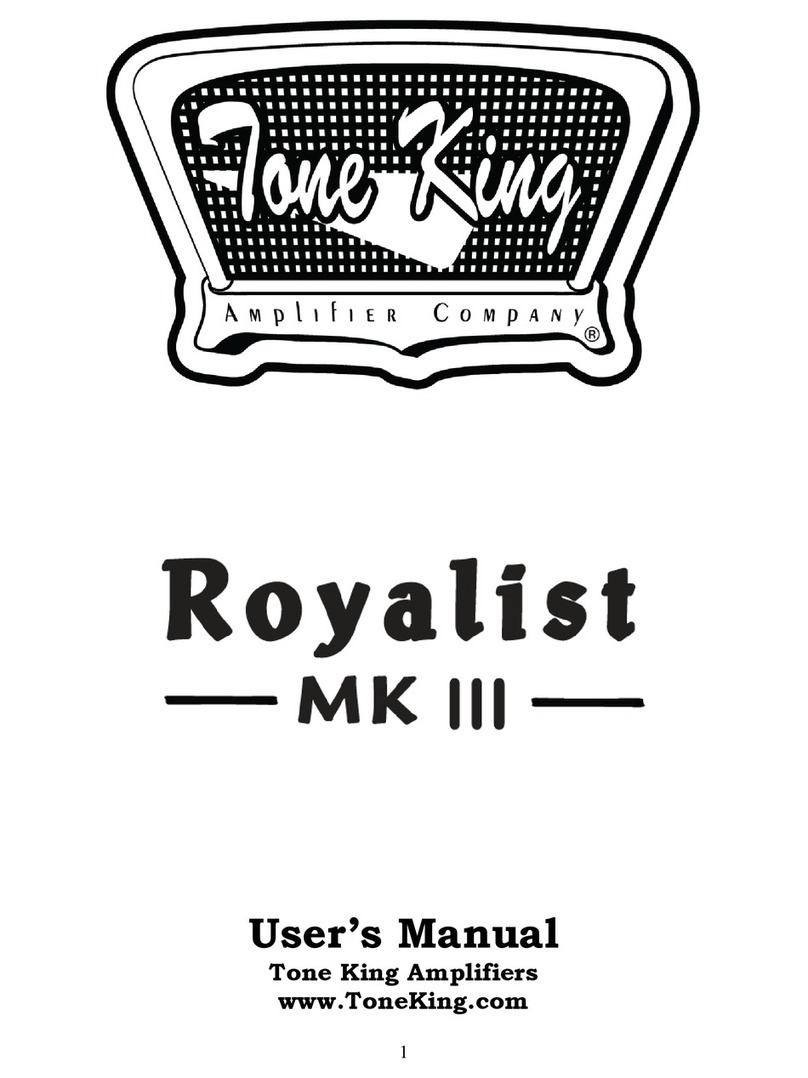
Tone King
Tone King Royalist MK III User manual
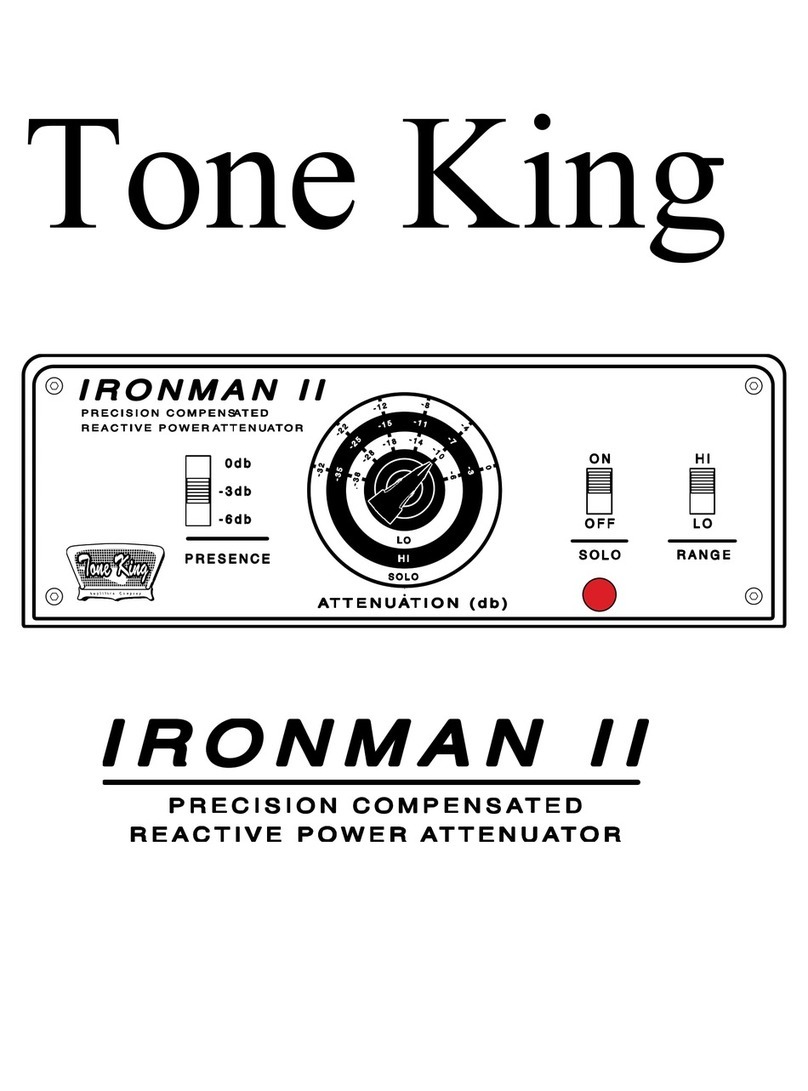
Tone King
Tone King Ironman II User manual

Tone King
Tone King Falcon Grande User manual

Tone King
Tone King Falcon Grande User manual

Tone King
Tone King FALCON User manual
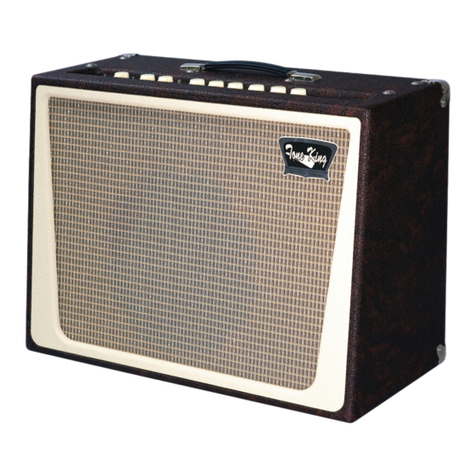
Tone King
Tone King Metropolitan User manual
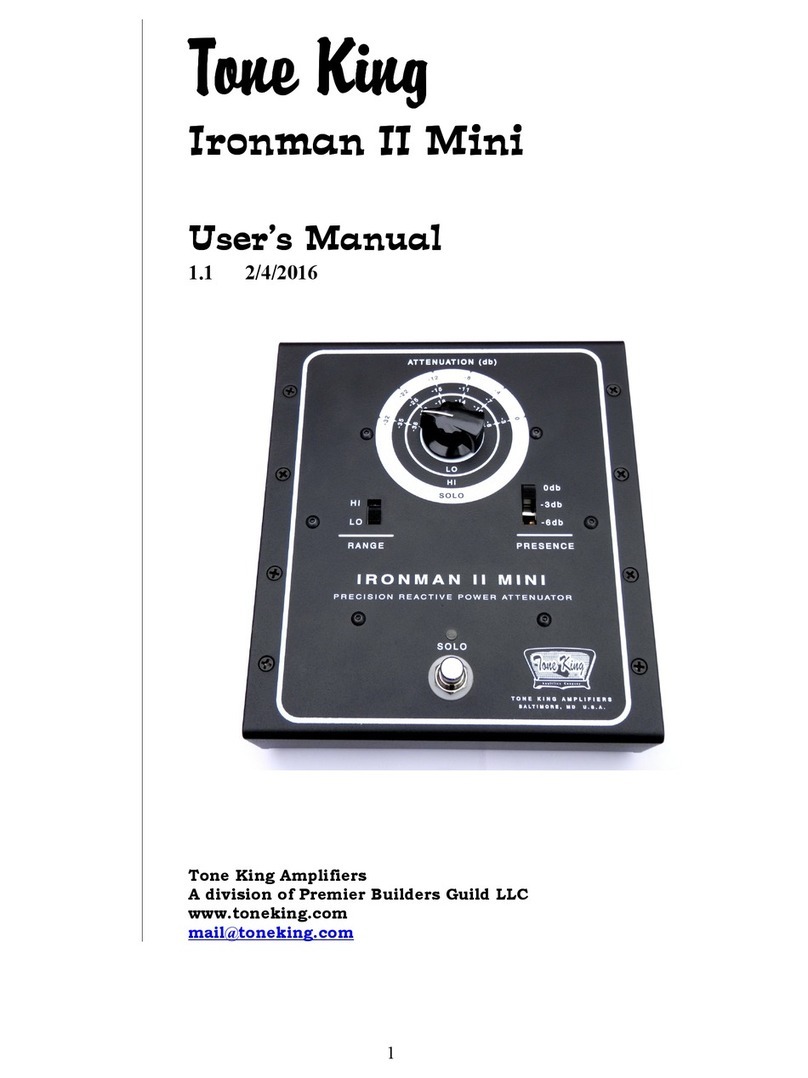
Tone King
Tone King Ironman II Mini User manual


